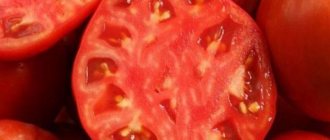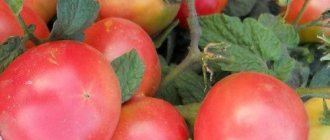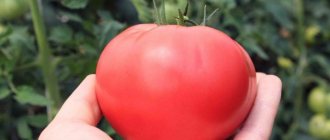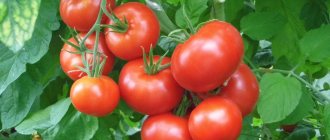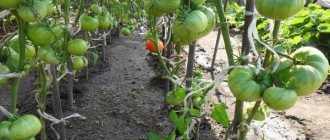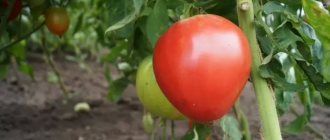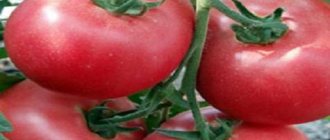Why do gardeners plant Darenka?
Summer residents are faced with the problem of lack of space. I want to plant a lot of things. For the desired result, it is recommended to follow the rules of crop rotation. The search for a suitable variety begins.
Darenka stands out among other tomatoes. It is planted in the southern regions and middle zone, in open ground and under shelters. The harvest is always a joy.
Characteristics that attract gardeners:
- indeterminate bush (on the street it grows up to 1.2 m, in unheated greenhouses it reaches up to 1.5 m);
- has an average ripening period (up to 125 days from germination to the first tomatoes);
- forms up to 12 brushes on each stem (when formed into 4 stems);
- Each brush contains a maximum of 6 tomatoes;
- foliage is average;
- leaf blades are dark green;
- size is large;
- If agricultural practices are followed, a tomato yields 3.5–4 kg/bush.
A distinctive feature of Darenka is its low requirements for lighting. The plant bears fruit in light shade. Withstands short-term drops in temperature (ovaries continue to form).
Description of the Darenka tomato variety, features of cultivation and care
All gardeners love the Darenka tomato. This mid-season variety pleases with fruits of universal use. It works great indoors and in outdoor beds. The fruits are tasty in salads and canned food.
Why do gardeners plant Darenka?
Summer residents are faced with the problem of lack of space. I want to plant a lot of things. For the desired result, it is recommended to follow the rules of crop rotation. The search for a suitable variety begins.
Darenka stands out among other tomatoes. It is planted in the southern regions and middle zone, in open ground and under shelters. The harvest is always a joy.
Characteristics that attract gardeners:
- indeterminate bush (on the street it grows up to 1.2 m, in unheated greenhouses it reaches up to 1.5 m);
- has an average ripening period (up to 125 days from germination to the first tomatoes);
- forms up to 12 brushes on each stem (when formed into 4 stems);
- Each brush contains a maximum of 6 tomatoes;
- foliage is average;
- leaf blades are dark green;
- size is large;
- If agricultural practices are followed, a tomato yields 3.5–4 kg/bush.
A distinctive feature of Darenka is its low requirements for lighting. The plant bears fruit in light shade. Withstands short-term drops in temperature (ovaries continue to form).
Why do gardeners love fruits?
Breeders offer many varieties of mid-season tomatoes. But Darenka stands out for her features. She combines polar qualities.
Description of tomatoes grown by summer residents:
- fruits of an elongated cylindrical shape with a “spout”;
- the weight of the tomato reaches 200 g (the first one grows to 300 g);
- unripe green tomato with a light spot in the stalk area;
- The color of the ripe berry is deep red;
- the skin is dense;
- fruits do not crack in wet weather;
- the pulp is tender, aromatic;
- the number of seeds is insignificant.
In warm, sunny summers, Darenka pleases with sweet fruits. Berries planted in the shade are sour and smaller.
Juiciness depends on regular watering.
Gardeners begin to enjoy the Darenka harvest in mid-August. Many varieties and hybrids have already been grown and tested. But the quality of the fruit does not disappoint. They are perfectly transported without loss of marketability.
How to get the desired result?
Compared to other tomatoes, Darenka is an unpretentious variety. But in order to obtain the yield specified by the breeders, it is recommended to comply with the growing requirements. The gardener should:
- sow seeds for seedlings in the third decade of March;
- the material from the manufacturer does not require testing for germination, disinfection, or stimulation;
- It is recommended to check the seeds you collected yourself for germination (dipped into a glass of water, empty ones float up);
- wash your material in a pink solution of potassium permanganate, soak in potassium humate for 2 hours;
- use fertilizers for seedlings (at least twice before planting in the ground);
- place on ridges after late spring frosts;
- overgrown seedlings should be buried down to the first leaves (those that are very elongated should be planted horizontally);
- For the success of growing Darenka, plants should be regularly fed with mineral complexes (before the tomatoes are poured);
- plants require gartering to supports, formation (maximum 4 stems), pinching and lightening.
The Darenka tomato variety is described in the State Register of Vegetable Crops of the Russian Federation. It is successfully cultivated in private household plots and small gardens.
What do they think about Darenka?
Gardeners like Darenka. Reviews about her are good. Gardeners gave a positive rating for taste, marketability, transportability, and universal use.
I wasn't happy with the size of the bush. Summer residents complain that covering tall plants outdoors is inconvenient.
Why do gardeners love fruits?
Breeders offer many varieties of mid-season tomatoes. But Darenka stands out for her features. She combines polar qualities.
Description of tomatoes grown by summer residents:
- fruits of an elongated cylindrical shape with a “spout”;
- the weight of the tomato reaches 200 g (the first one grows to 300 g);
- unripe green tomato with a light spot in the stalk area;
- The color of the ripe berry is deep red;
- the skin is dense;
- fruits do not crack in wet weather;
- the pulp is tender, aromatic;
- the number of seeds is insignificant.
In warm, sunny summers, Darenka pleases with sweet fruits. Berries planted in the shade are sour and smaller.
Juiciness depends on regular watering.
Gardeners begin to enjoy the Darenka harvest in mid-August. Many varieties and hybrids have already been grown and tested. But the quality of the fruit does not disappoint. They are perfectly transported without loss of marketability.
Tomato ORPHEUS F1
Syktyvkar, st. Morozova, 21
Mon-Fri from 10.00 to 19.00
Break from 14.00 to 14.30
Sat-Sun from 10.00 to 17.00
Home Vegetable and herb seeds Tomato ORPHEUS F1
Ultra-early ripening high-yielding tomato hybrid. From full germination to fruit ripening 80-85 days. The plant is medium-sized, 1.0-1.2 m high, plant foliage is weak. The inflorescence is simple and single-branched, loose with 6-7 beautiful fruits of an original ovoid shape with a notched or smooth apex of the fruit, weighing 80-90 g, with 2-3 chambers. The fruits are orange-red in color, dense in consistency, and have excellent taste. The sowing pattern depends on the irrigation method and soil type. We recommend growing through seedlings. The tomato hybrid Orpheus F1 is resistant to TDC, bacteriosis, and Alternaria.
Number of seeds per package – 15 pcs.
Fill in required fields *.
Vegetable and herb seedsTomatoes
Lily bulbs on sale
Dear Clients! Lily bulbs are on sale
1804.18 Availability of lily bulbs for sale.
How to get the desired result?
Compared to other tomatoes, Darenka is an unpretentious variety. But in order to obtain the yield specified by the breeders, it is recommended to comply with the growing requirements. The gardener should:
- sow seeds for seedlings in the third decade of March;
- the material from the manufacturer does not require testing for germination, disinfection, or stimulation;
- It is recommended to check the seeds you collected yourself for germination (dipped into a glass of water, empty ones float up);
- wash your material in a pink solution of potassium permanganate, soak in potassium humate for 2 hours;
- use fertilizers for seedlings (at least twice before planting in the ground);
- place on ridges after late spring frosts;
- overgrown seedlings should be buried down to the first leaves (those that are very elongated should be planted horizontally);
- For the success of growing Darenka, plants should be regularly fed with mineral complexes (before the tomatoes are poured);
- plants require gartering to supports, formation (maximum 4 stems), pinching and lightening.
The Darenka tomato variety is described in the State Register of Vegetable Crops of the Russian Federation. It is successfully cultivated in private household plots and small gardens.
Characteristics and description of the Darenka tomato
Darenka is a mid-season tomato that is suitable for growing in a greenhouse.
The bush is medium-sized, reaching a height of 1.2 m. The fruits are oval in shape, similar to a plum. The pulp is fleshy with a small number of seeds. The average weight of a ripe tomato is 150-200 g. Some specimens can reach a weight of 300 g. The fruits have a fairly dense peel, so they are perfect for pickling. They are also used in fresh salads due to their fragrant and tasty pulp. Productivity is about 3.5 kg per bush.
Another representative of greenhouse tomatoes - Darenka: full description of the variety and characteristics
The Darenka tomato is popular due to a number of beneficial bonuses - productivity, easy cultivation, and delicious taste. The variety is intended for cultivation in temporary shelters in the middle zone.
| Height | Landing location | Ripening time | Fruit color | Fruit size | Origin | Fruit shape |
| Medium height | Greenhouse, Open ground | Mid-season | Reds | Average | Variety | Plum-shaped or oval |
Description and characteristics of the variety
Tomato Darenka is a determinate medium-growing variety. The bushes are strong and compact, grow up to 1 m. Main characteristics of the fruit:
- average weight 150-200 g, the largest ones can reach 250-300 g;
- elongated shape, reminiscent of cream;
- there are few seed chambers;
- dense skin that does not crack;
- the taste is sweetish with a slight sourness;
- the pulp is moderately juicy and fleshy.
Tomatoes are used fresh for preparing salads and slices. They are also used to make winter preparations:
- canned whole or in pieces;
- dried in slices;
- prepare sauces and ketchups.
Advantages and disadvantages
- high commercial qualities;
- excellent taste;
- disease resistance;
- endurance of adverse factors.
Minuses:
- the need for garter and feeding.
Productivity
The yield from 1 bush is 4-4.5 kg, from 1 m2 they harvest 8-9 kg.
Features of cultivation and storage
Seeds are prepared for planting in early March. They are immersed in a saline solution and the even seeds that have sunk to the bottom are selected. To disinfect, soak for 10 minutes in potassium permanganate. For better germination, use “Kornevin” or “Epin”.
The seeds are laid out on the surface, sprinkled with a 1 cm layer on top, and compacted.
How to grow strong seedlings:
- before germination, the containers are placed at a temperature of 22-24 degrees;
- 1 week is hardened at 14 degrees;
- irrigate with warm water;
- fed with liquid solutions - organics and minerals.
Planting and care
Optimal placement is 3-4 bushes per 1 m2. The distance between holes is 50 cm, between rows is 60 cm. Plantings are not thickened for better lighting and the prevention of fungal diseases.
What care is required:
- formation in 3-4 shoots;
- applying fertilizers 1-2 times a month;
- mulching with green manure, peat, straw, ideal layer thickness 8-10 cm.
How to prepare a greenhouse
To be able to plant seedlings in the soil in May, you should stretch an additional layer of film over the greenhouse.
Advice! To increase the temperature in the greenhouse, you need to leave a layer of air between two layers of film.
To improve ventilation, it is necessary to build vents on all edges. Also, in order to protect the bushes from the appearance of diseases, a layer of soil measuring approximately 10-12 cm should be removed. And the one that remains should be treated with a solution of copper sulfate to prevent diseases.
Important! You should not plant tomatoes in the same greenhouse for two years in a row. This is because the infection can persist in the soil and infect fresh bushes.
The beds should be prepared 10 days before the intended planting in the soil. To do this, they are loosened, the remaining weeds are removed, and humus is added.
Features of planting tomatoes
When planting plants for permanent residence, you need to remember some rules.
- The soil for planting should be well warmed up. This is necessary in order to prevent root rot, which can lead to loss of bushes. To warm the soil, you can cover it with black film.
- Excessive deepening of seedlings is prohibited. This is because this can lead to the formation of additional roots and, as a result, stopping the growth of tomatoes.
- Do not use a lot of nitrogen. This can lead to the formation of excessively large tops, and the ovaries may be completely absent.
- You need to inspect the bushes very carefully before planting them in the soil. Remove yellowed leaves, as well as cotyledon leaves located at the very bottom.
- You need to plant tomatoes on gloomy days, and you can also plant them in the evening after the sun has already set.
Agricultural cultivation technology
Depending on the growing conditions, sowing seeds for seedlings is carried out 50-60 days before transplanting to a permanent place. To speed up germination and improve plant health, seeds are dipped in an aqueous solution of potassium permanganate.
In order to improve fruit set, it is recommended to treat the seed with a growth stimulant before planting it in the ground. The seeds are placed in containers with soil to a depth of 1.5 cm, after watering with warm water using a sprayer, the container is covered with film until shoots appear.
The optimal temperature for seed pecking is 23-25 °C. In the phase of formation of 2 true leaves, diving is carried out in separate containers with a soil mixture. For this purpose, it is better to use peat pots, in which they are planted in a permanent place.
During the growing season, the plant is periodically watered and fertilized with complex mineral fertilizers. It is recommended to periodically loosen the soil to create a balance of moisture and air near the root system.
How to care for tomatoes in a greenhouse
Watering
Experienced gardeners do not recommend watering tomatoes during the first 10 days after planting in the soil. For this, the water should be warm - +20-+22 degrees.
During the period of active growth of tomatoes, watering is carried out every 4-5 days, approximately 4-5 liters of water are consumed. per 1 m2. During flowering, the water consumption rate should be increased to 10-13 liters.
Ventilation
Optimal humidity and temperature are important conditions for growing tomatoes. Plants are not afraid of drafts, so they need ventilation. It is important to do this after watering.
Garter
Darenka grows up to 1.2 meters and needs to be tied to a support. Linear or frame trellises are suitable for the greenhouse.
Stepsoning
For tomatoes, it is extremely important to remove the shoots in a timely manner, all because the side shoots can shade the bush, which significantly increases the ripening time of tomatoes.
Top dressing
10-15 days after planting the tomatoes, the first feeding should be done. To do this, you can use the following solution: 10 l. water, 1 tbsp. nitrophoska and 0.5 liters of liquid mullein. For one bush you need 1 liter. solution.
The next feeding is carried out 10 days after the first. To do this you should take 10 liters. water, 1 hour. l. potassium sulfate, 1 tbsp. fertilizers "Fertility". You need 3-4 such feedings over the entire season.
Characteristics of the Eastern Star tomato and description of the hybrid variety
The Star of the East tomato, the characteristics and description of the variety of which classifies the hybrid as a cluster tomato, is distinguished by its early ripening period and resistance to stressful growing conditions.
Advantages of a hybrid
Tomato Star of the East F1 belongs to the first generation hybrids. The variety is intended for cultivation in closed ground conditions. The tomato is characterized by resistance to temperature changes, fungal and viral diseases of nightshade crops.
The peculiarities of the hybrid are the early ripening of tomatoes. It takes 90-95 days from the appearance of the first shoots to fruiting. During the growing season, the bushes reach a height of 60-80 cm. The stems require shaping, removing excess shoots and tying them to a support.
Agricultural cultivation technology
Sowing seeds for seedlings is carried out in the first half of March. Before planting in the ground, the seeds are treated with a growth stimulator. In the phase of formation of 1-2 true leaves, seedlings are picked into separate pots.
Plants are transferred to the ground in mid-May. The bushes are placed at a distance of 40-50 cm from each other, maintaining a distance of 70 cm between rows. Ripe tomatoes are harvested in July and August.
Hybrid Star of the East is demanding of sunlight. Heat is one of the main factors determining the rate of crop growth and fruit ripening. For normal tomato development, air humidity is of great importance, which should be at the level of 50-60%.
It is recommended to regularly water with warm water after sunset. To ensure high crop yields, it is necessary to fertilize with mineral fertilizers containing potassium and phosphorus.
Caring for the plant involves timely weeding and loosening the soil. To ensure a balance of moisture and air near the root system, the soil is mulched using last year's grass, leaves and special fiber.
Opinions and recommendations of vegetable growers
Thanks to its excellent characteristics, the hybrid has gained popularity among gardeners and has earned positive reviews. Tips for growing crops relate to preparing the soil, applying complex fertilizers, moderate watering and maintaining air humidity.
Andrey Alferev, 56 years old, Biysk.
I choose the hybrid Star of the East for many seasons in a row. Among the positive characteristics, I would like to point out the high yield of the crop and immunity to various diseases. The fruits ripen in clusters, which are easy to remove from the bush without damage. Tomatoes are raspberry-colored, very aromatic, great for fresh consumption and canning. But to ensure a high yield, you have to monitor air humidity and timely feed the plants with complex preparations according to the manufacturer’s scheme.
Alexandra Ivanova, 51 years old, Kostroma.
The Eastern Star learned about the hybrid from a neighbor who treated her to these tomatoes. I really liked the sweet and pleasant-tasting fruits, so I immediately ordered the seeds. Last season I grew it in a greenhouse using seedlings, observing the requirements for lighting conditions, temperature and air humidity. During the growing season, she formed bushes, removed excess shoots, and applied fertilizers. The result of the work pleased with the high yield, which reached almost 35 kg per 1 m². Tomatoes with a rich taste tolerate long-term storage in the refrigerator.
How to determine if a plant is missing something
- Nitrogen deficiency is characterized by a change in the color of the stem, as well as leaves and fruits. The leaves become smaller and acquire a yellowish tint, and the fruits become much harder and smaller.
- When there is a lack of phosphorus in the soil, the leaves curl.
- A lack of potassium is characterized by curly leaves.
- If there is a lack of calcium in the soil, the leaves become covered with yellow spots.
- The lack of sulfur manifests itself primarily on young leaves. They become light green, then turn yellow. In this case, the stems become excessively brittle.
- A lack of boron is characterized by blackening of the stem at the growing point, and the fruits may become covered with brown spots.
Reviews
The tomato fully corresponds to what is written about it. Grown by seedlings in a film greenhouse. Overall I liked the variety. The tomatoes are very beautiful, tasty and look great in a jar. I also really liked the canned ones; the thick skin did not allow the fruits to crack.
This year I met Darenka. Great tomatoes. The color of the unripe ones was too dark in my opinion. But when ripe they acquired a rich red hue. Tomatoes are delicious. I will still plant.
Tomato Miracle of the Lazy: review, description, photo
There is no such tomato among those officially registered in the State Register! But! The male gardener YURY PETROV described them so well that I cannot remain silent and not share. Why should I be the only one to suffer and want such tomatoes?




